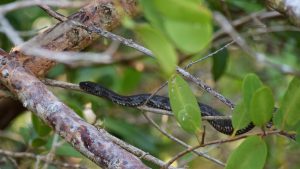Recently, while filming a mangrove video at Lemon Bay Park in Sarasota County, I spotted a beautiful snake, resting a few feet from me while well-hidden in the branches of a gorgeous red mangrove. The snake remained motionless, like most snakes will do when they sense the presence of humans or other dangers. But, I still was able to make out this wonderful creature, a mangrove salt marsh snake.
While I absolutely love snakes, many people fear them (some to extreme degrees, or what is known as “ophidiophobia”). But why? Some research suggests humans, throughout evolutionary history, learned to fear snakes to increase their survival chances. Some scientists posit that early primates developed a better eye for color, detail, movement, and the ability to see in three dimensions to be able to detect threats in the wild, such as snakes. Still others have concluded that the fear of snakes is set in childhood through observational conditioning; that is, as young watch and mimic the behavior of their parents or elders
Often lost in that fear is the fact that snakes don’t really pose a threat to the survival of our species. Highlighting that message, along with sharing the many benefits that snakes bring to humans, can go a long way to improving perceptions and actions. And that is the aim of this blog: education.
Snake facts

This non-venomous snake is one of three subspecies of N. clarkia.
Endemic to Florida, mangrove salt marsh snakes reside in estuaries, salt marshes, and tidal mud flats along the coastlines of the Gulf of Mexico and Atlantic Ocean, from west-central Florida down to the Keys and back around to Brevard County.
Fully grown, the mangrove salt marsh snake measures 14-28 inches long. Though relatively small, this animal plays a very important role in nature, balancing the food web as both predator and prey. This snake feeds on crabs, small fishes, shrimp, and other invertebrates.
Mature mangrove salt marsh snakes can vary in color, from grayish-olive to brown to rusty orange with faint darker bands. Some specimens might be almost entirely black, even. That color variation can cause problems, since the non-venomous marsh snake is sometimes mistaken for the venomous cottonmouth.
Venomous or not
A good way to distinguish between the two is to closely look at the snake’s head: the position of the eyes, the shape of the eye pupils, and the shape of the whole head. The Florida Museum has a great infographic to help. And, the museum has a wonderful online guide with information about all of Florida’s snake species.
One great message from that guide, and the takeaway from this blog post, is that snakes are extremely important to our ecosystems and, because of that, to us. Most snakes in Florida are harmless, and even the few venomous species here would far prefer to avoid human contact.
If you’re not a snake fan, like me, I’d suggest reading up on some of our state’s amazing snakes. The more you learn about them, the more amazing they seem, and the more likely you are to enjoy them rather than fear them.
If you have questions about the mangrove salt marsh snake, please do not hesitate to contact me. And if you have a picture of an organism that you would like to learn more about, please fill out my short “What in the World is This?” online form so we can start investigating.
Let’s keep learning about our wonderful marine biodiversity and discovering more cool facts about the inhabitants of (and along) our oceans.
 2
2
